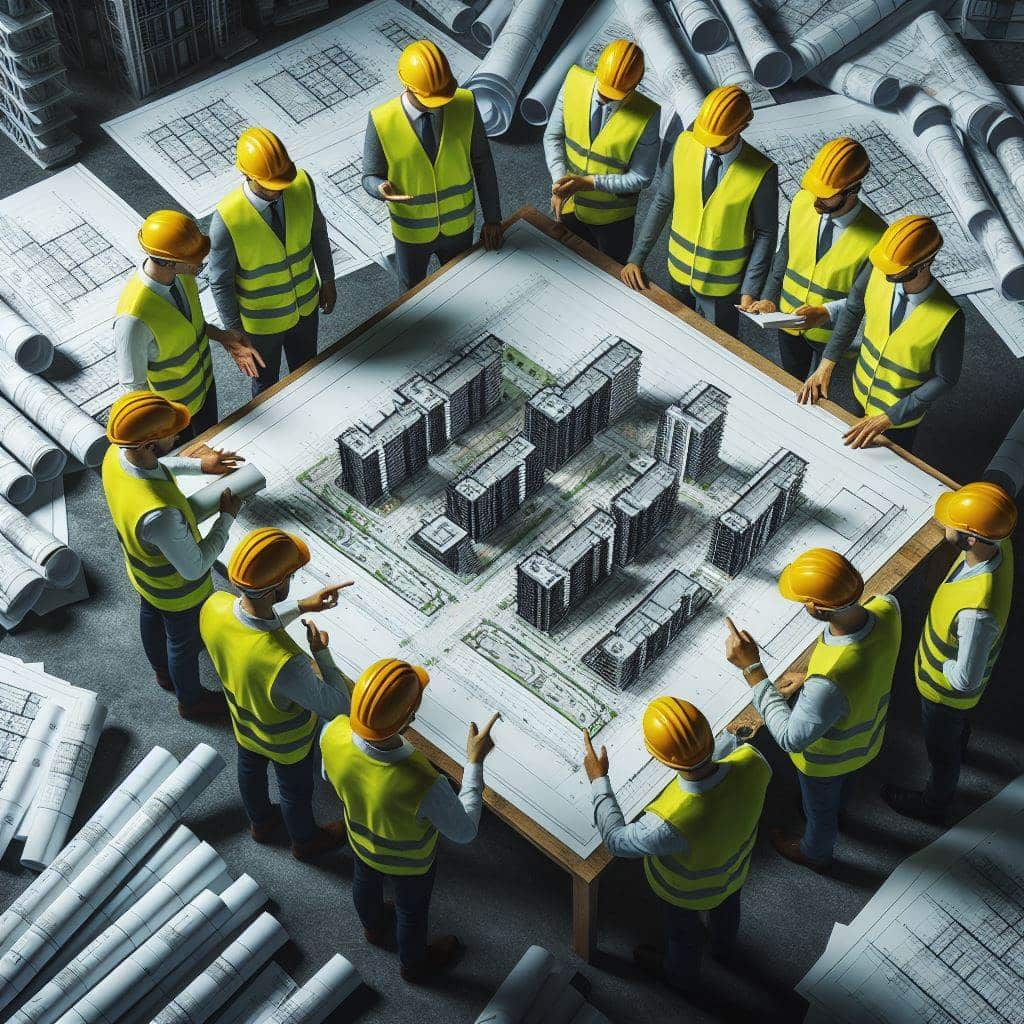Construction project management is the process of overseeing every aspect of a construction project from conception to completion. It involves a wide range of responsibilities like planning and defining the project scope, budgeting, assigning responsibilities, and collaborating with various building professionals.
A well-managed construction project ensures effective and timely delivery to clients. It also helps save costs and prevent issues that could hinder the quality of work done.
This simple guide will equip you with the important things you need to know when managing a construction project. Ready? Let’s get started.
Why is construction project management important?
Effective construction project management is vital to the success of a building project as it helps to ensure that all parties involved in the project are on the same page. Thorough planning, for instance, lays the groundwork and sets the direction for the project. This, in turn, ensures that there is a seamless workflow.
That said, other major reasons to prioritize construction project management include:
Maintenance of quality standards – Proper project management helps to maintain high-quality standards. This is because the construction management team would typically identify the criteria for all resources used for construction and put measures in place to ensure compliance.
Risk management and avoidance – Site investigations are important aspects of the pre-construction process. It’s how project managers can uncover potential issues with the building site and develop a more feasible project execution strategy. For instance, a site investigation might reveal unstable soil conditions. With this knowledge, architects and engineers can adjust their blueprints to address this issue. They could propose foundation solutions like pilings piers, or soil stabilization to guarantee the building’s stability and safety in the long run.
Prevention of cost overruns – Managing a construction project also involves creating an accurate project budget or proactively assessing the project to identify potential issues which would have been too costly to fix. Also, regular progress monitoring allows for early detection of deviations from the budget and schedule.
Best Practices for Construction Project Management
Moving on, we’ll now explore key best practices for each phase of your construction project management.
01. Project Planning: Goal Definition, Scheduling, and Budgeting
Before diving deep into the intricacies of your project, you want to clearly define your project’s overall objectives in alignment with the project owner’s requirements. For instance, what type of building is going to be put up, and what simple or complex resources are required to achieve this? Is it something with complex or basic infrastructure? Ideally, your client should provide you with sufficient information in these areas. As a construction project manager, it’s your responsibility to get as much relevant information as you need from your clients or project owners.
Next, create a comprehensive project schedule that outlines critical stages in your construction process. From ideation to final inspections, these schedules should include key milestones, dependencies, and feasible timeframes for each activity. Drafting your construction schedule is not something to do alone. Advisably, ensure that you involve key participants in the actual project execution. This way, you’ll be better informed of timelines leading up to the completion of the project.
Afterwards, you’ll create a detailed budget that considers all potential costs including materials, labor, equipment rentals, and permits. You’ll also be setting up a contingency fund, considering all risks associated with the project. Typically, this may be up to 5-10% of your total project budget. 
Image credit: GocodesMake effective use of market research to ensure that your price estimations are accurate enough. As you did with the timelines, involve key stakeholders like architects, engineers and contractors in the budgeting process. Other estimation methods you can adopt are:
- The parametric approach – uses historical data and statistical modelling to determine the current value of items in your project. And,
- Bottom-up estimation – estimates the costs of individual work items for each project task and sums them up to determine the total project budget.
If your organization does not already have a robust set of tools, or if you are seeking alternatives, some project budgeting tools you can use include Archdesk, Xero, and Freshbooks.
Prioritize maintaining consistent and up-to-date documentation of your project. For instance, project plans, construction drawings, permits, and even communication records should have a central repository that’s easily accessible. This is particularly helpful when there’s a need to make references in the course of implementing project plans.
02. Project Execution: Resource allocation, quality control, and progress monitoring
Here, your carefully crafted plans transition into a more tangible process. The project execution phase would often involve allocating resources for the project and coordinating teams for various tasks. You’ll also need to continuously monitor the progress of work against your initial plan. This is to help identify deviations and make corrections where necessary to prevent delays or cost overruns.
Quality assurance and control is another crucial aspect of the project execution process. The aim is to ensure that the construction work and materials used adhere to the project specifications and quality standards. It’s important to note that quality control procedures like material testing, inspections, and workmanship verification can help to preserve the integrity of your project.
Remember to refer to floor plans and other construction drawings to ensure alignment between design and construction. Also, you must maintain clear and consistent communication with all project stakeholders. Hold regular meetings to discuss progress and address pressing concerns that can impact timely delivery and budget. Overall, keep in mind that both small and large tasks contribute to the successful completion of your project. So, nothing should be overlooked.
03. Project Completion: Inspections, Approvals, and Handovers
This is the final lap in your construction project. Here, you want to ensure a smooth handover to your clients. Ideally, a series of final inspections are carried out by the appropriate personnel— usually, this would be a group of inspectors from the relevant government agency in the building’s location. In Lagos, Nigeria, for instance, that would be the Lagos State Building Control Agency (LASBCA).
These inspectors possess the necessary expertise to ensure the completed construction adheres to all plans, specifications, and building codes. Once all standard building requirements check out, the necessary approvals will be granted. Inspectors would often look out for accessibility, structural integrity, plumbing and electrical systems, safety, etc.
As you wrap up your project, ensure that you accurately settle pending contracts with architects, engineers, subcontractors, and other professionals who were engaged in the project. Also, make it a priority to evaluate your team’s performance. Compare your goals and objectives in terms of budget, schedule, and quality. Capture key insights and recommendations, as they could be useful in future projects.
Construction drawings in project planning and execution
Construction drawings are a graphic representation of how a structure will be built. They serve as the cornerstone of all the design team’s intentions and a map for the building contractor to execute the client’s approved program. Typically, the construction drawings serve as a clear guide for everyone involved in the building process. So, it maintains relevance in all phases of your construction project.

Breaking it down, here’s how construction drawings are useful throughout a building project:
In the planning phase, construction drawings like floor plans, elevations, or MEP (Mechanical, Electrical, and Plumbing) help to establish the project’s scope by highlighting the physical dimensions, spatial layers, and materials needed for every element of the building. This, in turn, helps with cost estimation and effective scheduling of dependencies.
In project execution, construction drawings provide engineers, builders, and other on-site crew members, with the precise instructions needed to accurately deliver. For instance, the engineers are well-informed on the exact sequence and methods for installing structural components like beams and columns. Plumbers are instructed on how to precisely install piping systems throughout the building, while bricklayers can ensure walls are constructed to the correct dimensions and specifications. You can print these construction drawings or distribute them digitally for easy access.
Additionally, you and your team can use construction drawings to ensure that the completed building adheres to the planned layouts. In cases of slight modifications, As-built drawings can be created to reflect them. Finally, let’s not forget about how construction drawings are also requirements for important building approvals.
Conclusion
The construction journey from concept to completion in construction is quite complex. However, a well-designed construction management process can help project managers and construction teams navigate the process with more confidence.
In this post, we explored how effective project management fosters a collaborative environment and ensures that quality standards are met. For instance, teams can identify and tackle potential issues before they escalate. We also looked into how construction drawings can serve as an essential blueprint throughout all phases of the construction process. From informing the initial planning decisions to guiding on-site construction and final inspections, these documents are instrumental to an effective project execution process.
Overall, we can say that proper documentation paired with clear construction management tactics will allow construction professionals to optimize the building process and deliver more exceptional structures.
Choose the right partners for efficiency. Contact PrintMyDrawings for the following printing needs
- Architectural Design Drawings
- Construction Detail Drawings
- Electrical Drawings
- Engineering Drawings
- Mechanical Drawings
- Business Documents







